Discover 50 hidden attractions, cool sights, and unusual things to do in Brazil. Don't miss out on these must-see attractions: Christ the Redeemer Statue (Rio de Janeiro), Sugarloaf Mountain (Rio de Janeiro) or MAM (Rio de Janeiro).
Below, you can find the list of the most amazing places you should visit in Brazil.
Table of Contents
Christ the Redeemer Statue, Rio de Janeiro
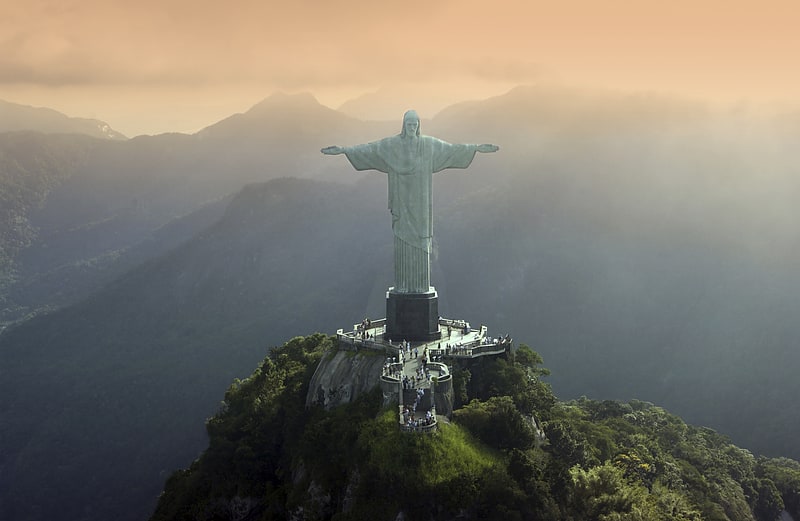
Also known as: Cristo Redentor
Iconic Christ statue atop a mountain. Christ the Redeemer is an Art Deco statue of Jesus Christ in Rio de Janeiro, Brazil, created by French sculptor Paul Landowski and built by Brazilian engineer Heitor da Silva Costa, in collaboration with French engineer Albert Caquot. Romanian sculptor Gheorghe Leonida fashioned the face. Constructed between 1922 and 1931, the statue is 30 metres high, excluding its 8-metre pedestal. The arms stretch 28 metres wide. It is made of reinforced concrete and soapstone.
The statue weighs 635 metric tons (625 long, 700 short tons), and is located at the peak of the 700-metre (2,300 ft) Corcovado mountain in the Tijuca National Park overlooking the city of Rio de Janeiro. A symbol of Christianity around the world, the statue has also become a cultural icon of both Rio de Janeiro and Brazil and was voted one of the New Seven Wonders of the World.[1]
Address: Estr. do Corcovado, s/n, 20531-540 Rio de Janeiro
Sugarloaf Mountain, Rio de Janeiro
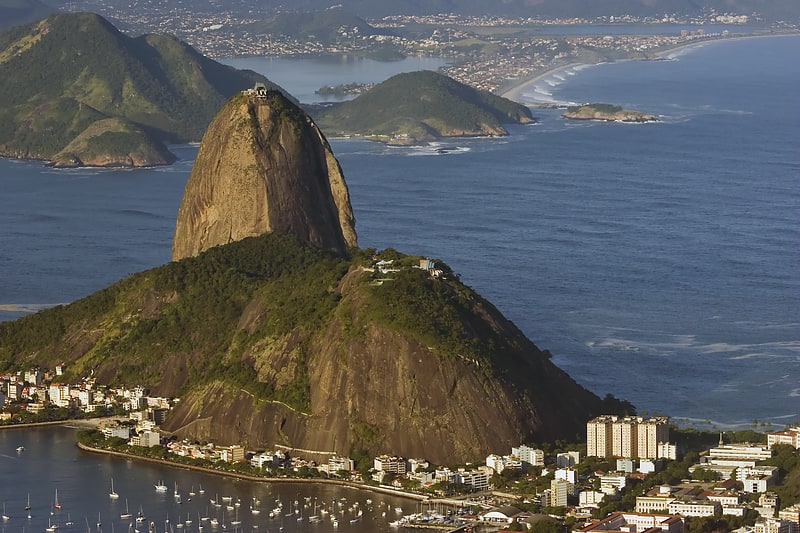
Also known as: Pão de Açúcar
Peak with a cableway and panoramic views. Sugarloaf Mountain is a peak situated in Rio de Janeiro, Brazil, at the mouth of Guanabara Bay on a peninsula that juts out into the Atlantic Ocean. Rising 396 m above the harbor, its name is said to refer to its resemblance to the traditional shape of concentrated refined loaf sugar. It is known worldwide for its cableway and panoramic views of the city and beyond.
The mountain is one of several monolithic granite and quartz mountains that rise straight from the water's edge around Rio de Janeiro. Geologically, it is considered part of a family of steep-sided rock outcroppings known as non-inselberg bornhardts.
The mountain is protected by the Sugarloaf Mountain and Urca Hill Natural Monument, created in 2006. This became part of a World Heritage Site declared by UNESCO in 2012.[2]
Address: Av. Pasteur, 520, 22290-255 Rio de Janeiro (Botafogo)
MAM, Rio de Janeiro
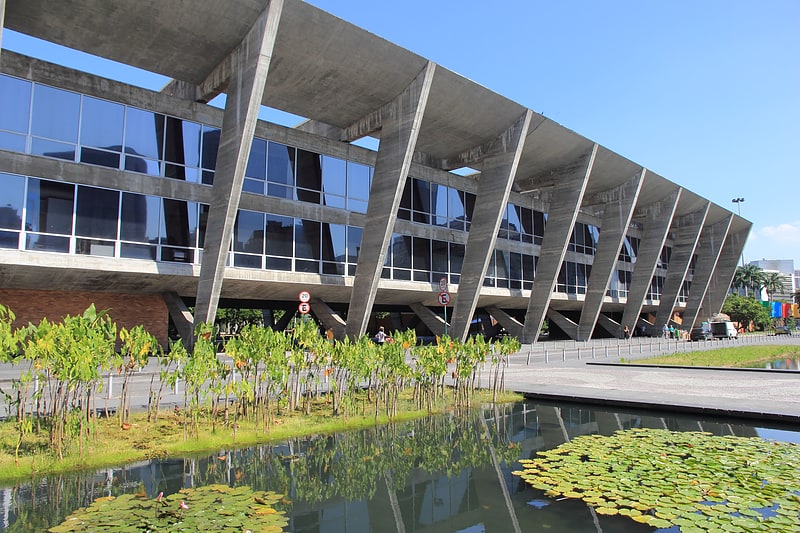
Also known as: Museu de Arte Moderna do Rio de Janeiro
Modern art museum with unique gardens. The Museum of Modern Art in Rio de Janeiro is a museum located in northeastern Flamengo Park, in the city of Rio de Janeiro, Brazil. It is in the Centro district, west of Santos Dumont Airport, on Guanabara Bay.[3]
Address: Av. Infante Dom Henrique, 85, 20021-140 Rio de Janeiro (Botafogo)
Ibirapuera Park, São Paulo

Also known as: Parque Ibirapuera
Park in São Paulo, Brazil. Ibirapuera Park is an urban park in São Paulo. It comprises 158 hectares between Av. República do Líbano, Av. Pedro Alvares Cabral, and Av. IV Centenário, and is the most visited park in South America, with 14.4 million visits in 2017.
Ibirapuera Park was the first metropolitan park in São Paulo, designed along the lines of other great English landscape gardens built in the 20th century in major cities around the globe, but inspired on modern drafts from the landscape architect Roberto Burle Marx. It was inaugurated on 21 August 1954 for the 400th anniversary of the city of São Paulo with buildings designed by architect João Felipe Pereira and landscape by agronomist Otávio Augusto Teixeira Mendes. The construction of several pavilions in the park was controversial when the park was designed, and group of people advocated for an exclusively green park rather than one that included buildings. In the 90s, its green areas were graded heritage-listed status by the city and the state of São Paulo to avoid further construction and keep its historical gardens and green open spaces preserved. In 2016, the complex of buildings designed by Niemeyer in the park were also registered as national landmark by the National Historic and Artistic Heritage Institute.
Ibirapuera is one of Latin America's largest urban parks, together with Chapultepec Park in Mexico City and Simón Bolívar Park in Bogota, and its iconic importance to São Paulo is often internationally comparable to that of Central Park to New York City. The park is often cited as one of the most vibrant and photographed parks in the world, as together with its large area for leisure, jogging and walking, it hosts a vivid cultural scene with museums, a music hall, and popular events such as São Paulo Fashion Week, congresses and trade shows. It is claimed to be the most visited urban park in South America, is listed as one of the best parks in the world, and has been described as "a green oasis at the heart of a concrete jungle".
The park has been managed for decades by the city of São Paulo, but the local government plans to concession all its parks' management to private hands, starting with Ibirapuera Park. Since 2014, the park also has the support of the Ibirapuera Park Conservancy (Parque Ibirapuera Conservação), a strong community nonprofit that supports park stewardship and conservation actions through a capital improvement plan, engagement projects and volunteer work. Admission to the park has been free since 1954, and it is open from 5am until midnight every day.[4]
Address: Av. Pedro Álvares Cabral, 04094-050 São Paulo (Vila Mariana)
Pinacoteca do Estado de São Paulo, São Paulo
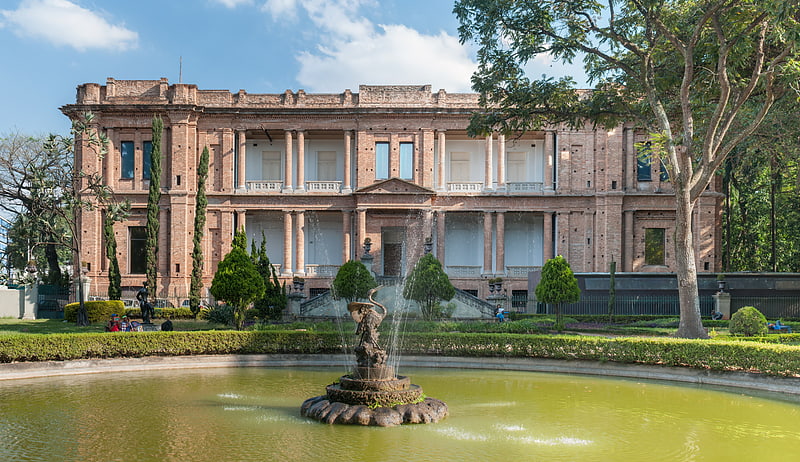
Established museum for Brazilian artwork. The Pinacoteca do Estado de São Paulo is one of the most important art museums in Brazil.[5]
Address: Praça da Luz, 2, 01120-010 São Paulo (Sé)
São Paulo Museum of Art, São Paulo
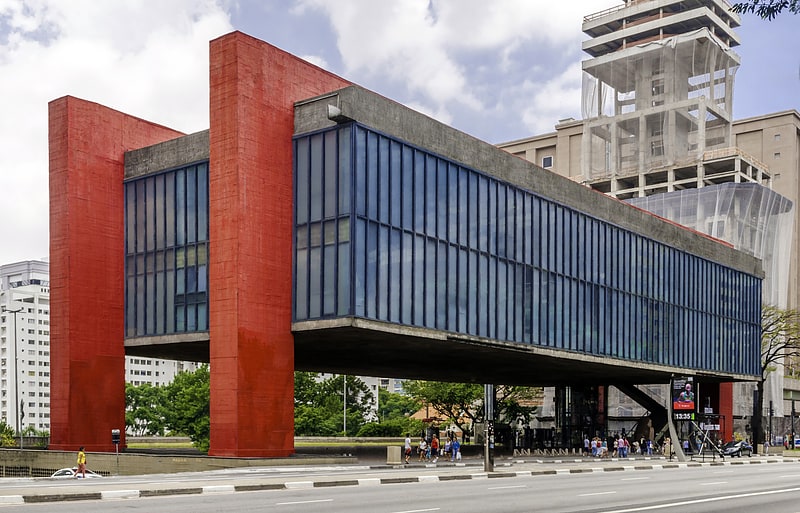
Also known as: Museu de Arte de São Paulo
Large collection by renowned artists. The São Paulo Museum of Art is an art museum located on Paulista Avenue in the city of São Paulo, Brazil. It is well known for its headquarters, a 1968 concrete and glass structure designed by Lina Bo Bardi, whose main body is supported by two lateral beams over a 74 metres freestanding space, considered a landmark of the city and a main symbol of modern Brazilian architecture.
The museum is a non-profit institution founded in 1947 by Assis Chateaubriand and Pietro Maria Bardi. MASP distinguished itself for many important initiatives concerning museology and art education in Brazil, as well as for its pioneering role as a cultural center. It was also the first Brazilian museum interested in post-World War II art.
The museum is internationally recognized for its collection of European art, considered the finest in Latin America and all Southern Hemisphere. It also houses an emphatic assemblage of Brazilian art, prints and drawings, as well as smaller collections of African and Asian art, antiquities, decorative arts, and others, amounting to more than 8,000 pieces. MASP also has one of the largest art libraries in the country. The entire collection has been named by Brazil's Institute of History and Art to the Brazilian National Heritage list.[6]
Address: Av. Paulista, 1578, 01310-200 São Paulo (Sé)
Palácio do Planalto, Brasilia
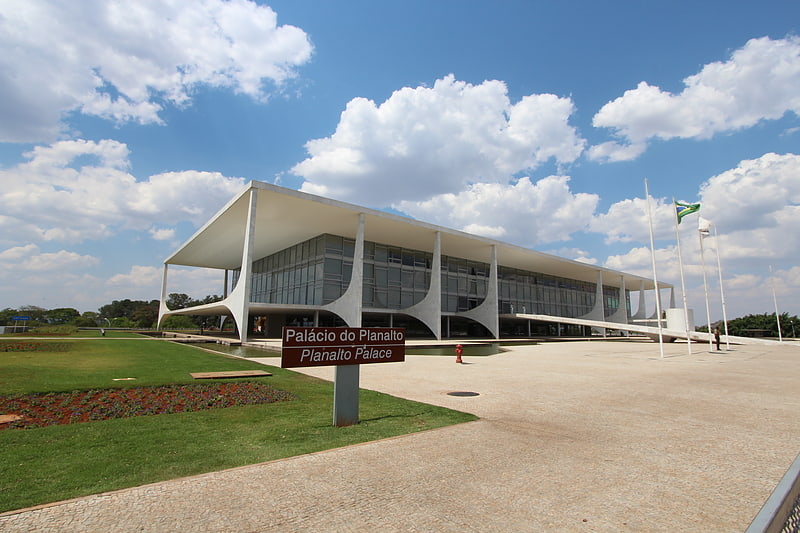
Iconic building with presidential office. The Palácio do Planalto in Brasília is the official workplace of the president of Brazil. The building was designed by architect Oscar Niemeyer in 1958 and inaugurated on April 21, 1960. It has been the workplace of every Brazilian president since Juscelino Kubitschek. It is located at the Praça dos Três Poderes, to the east of the National Congress of Brazil and across from the Supreme Federal Court.
It is one of the official palaces of the Presidency, along with the Palácio da Alvorada, the official residence. Besides the President, other high ranking government officials also work from the Planalto, including the Vice President and the Chief of Staff; the other government ministry buildings are located on the Ministries Esplanade. As the seat of government, the term Planalto is often used as a metonym for the executive branch of the federal government.
The building, constructed in the modernist style, is part of the Brasília World Heritage Site, designated by UNESCO in 1987.[7]
Address: Praça dos Três Poderes, 70150-900 Brasilia (RA I - Brasília)
Palácio da Alvorada, Brasilia
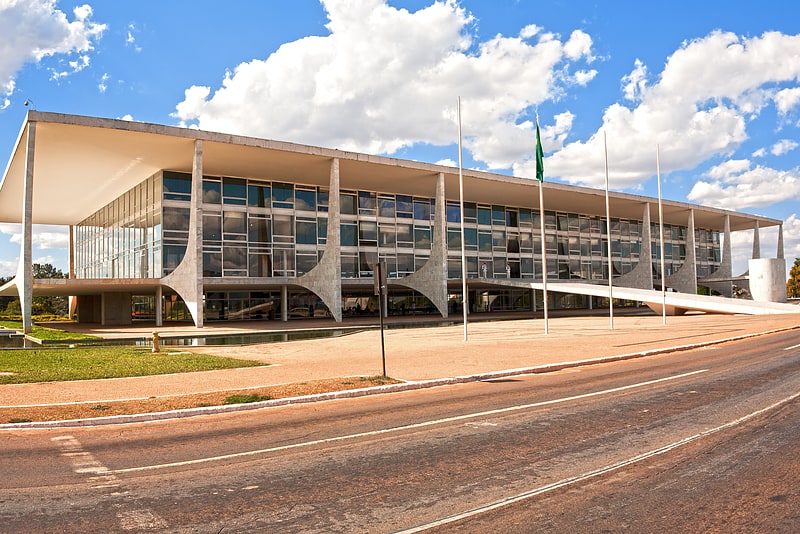
Modernist home of Brazil's president. The Palácio da Alvorada is the official residence of the President of Brazil. It is located in the national capital of Brasília, on a peninsula at the margins of Paranoá Lake. The building was designed by Oscar Niemeyer and built between 1957 and 1958 in the modernist style. It has been the residence of every Brazilian president since Juscelino Kubitschek. The building is listed as a National Historic Heritage Site.[8]
Address: Brasilia, Via Presidencial, Zona Cívico-Administrativa – CEP 70150-000
Cathedral of Brasília, Brasilia

Also known as: Catedral Metropolitana de Brasília
Cathedral featuring avant-garde design. The Cathedral of Brasília is the Roman Catholic cathedral serving Brasília, Brazil, and serves as the seat of the Archdiocese of Brasília. It was designed by Brazilian architect Oscar Niemeyer and calculated by Brazilian structural engineer Joaquim Cardozo, and was completed and dedicated on May 31, 1970. The cathedral is a hyperboloid structure constructed from 16 concrete columns, weighing 90 tons each.[9]
Address: Esplanada dos Ministérios, Lt. 12, 70200-610 Brasília (RA I - Brasília)
Museum of Modern Art of Bahia, Salvador
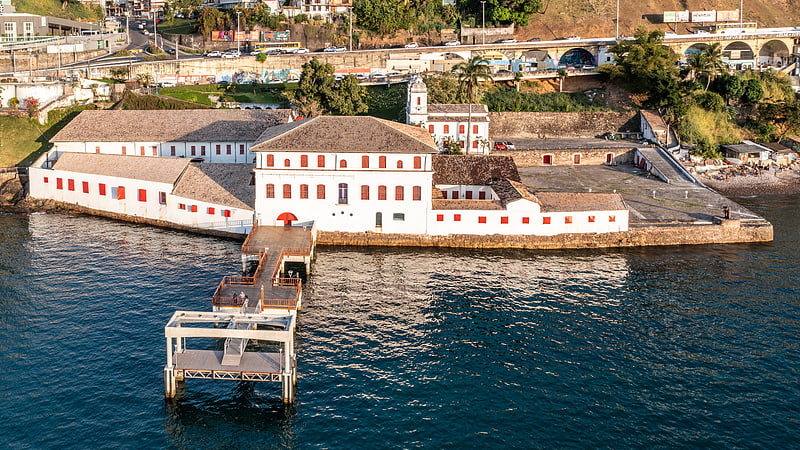
The Museum of Modern Art of Bahia is a modern art museum located in Salvador, Bahia, Brazil. It is located within Solar do Unhão, a historical site dating to the 16th century, on the margin of the Bay of All Saints. The museum was founded in 1960 under the architect Lina Bo Bardi and initially located in the foyer of the Castro Alves Theater; it moved to its present location in 1963. MAM-BA is one of twelve state museums linked to the Institute of Artistic and Cultural Heritage, an authority of the Department of Culture of the State of Bahia.
The collection of MAM-BA is noted for paintings, sculptures, photographs, and drawings by artists such as Tarsila do Amaral, Portinari, Flávio de Carvalho, Di Cavalcanti, Rubem Valentim, Pancetti, Carybé, Mário Cravo Neto, and Sante Scaldaferri. MAM-BA has eight exhibition rooms; a theater; a library; a technical space to house conservation, restoration, and museology; and an art workshop that offers open courses of painting, engraving techniques, ceramics, drawing, handmade paper, and sculpture to the community.[10]
Address: Av. Contôrno, s/n, 40301-155 Salvador (Centro)
Igreja do Bonfim, Salvador

Also known as: Igreja Nosso Senhor do Bonfim
Famed 18th-century Catholic church. The Church of Nosso Senhor do Bonfim is the most famous of the Catholic churches of Salvador, in the State of Bahia, Brazil. It was built in the 18th century on the only line of hills in the Itapagipe Peninsula, in the lower town of Salvador. The church is the subject of intense religious devotion by the people of Salvador and is the site of a famous celebration held every year in January, the Festa do Senhor do Bonfim. The church is the Cathedral of the Roman Catholic Diocese of Bonfim. The church is noted for the Festa do Bonfim, held annually the second Thursday after Three Kings Day. The festival combines elements of both Catholicism and Candomblé. It was listed as a historic structure by the National Historic and Artistic Heritage Institute in 1938.[11]
Address: Largo do Bonfim, s/n, 40415-475 Salvador (Itapagipe)
Fort of Monserrate, Salvador
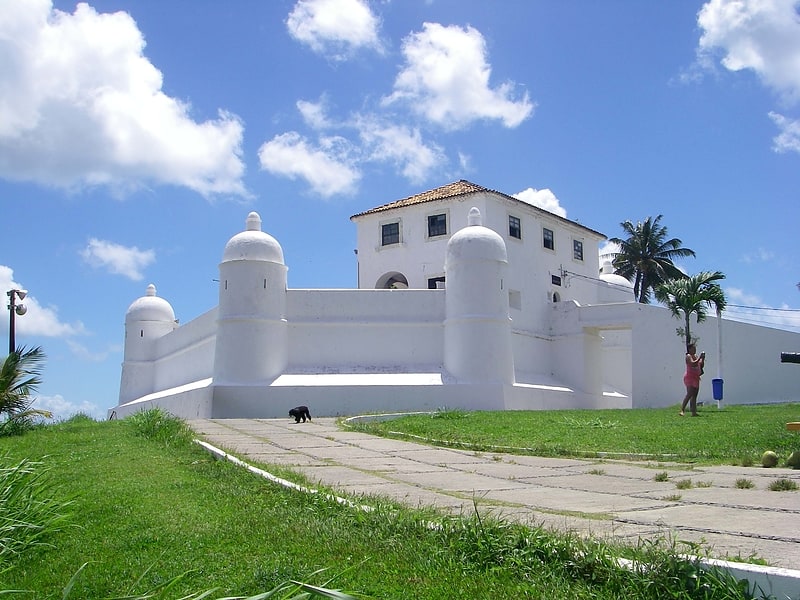
The Fort of Monserrate is a military fortification located in Salvador, Bahia in Brazil. It is also known as the Small Fort of Our Lady of Monserrate. It was known as the Forte de São Felipe from the time of its construction until the 19th century. The Fort of Monserrate was built between the end of the 16th century and early 17th century on the Itapagipe Peninsula. It is "one of the few Brazilian fortifications to retain its original appearance from the late 16th century." The fort is located above the Church and Monastery of Our Lady of Monserrate, one of the oldest church structures in Brazil. The fort was listed as a historic structure by the National Institute of Historic and Artistic Heritage in 1938.[12]
Address: R. da Boa Viagem, 471-593, 40414-610 Salvador (Itapagipe)
Botanical Garden of Curitiba, Curitiba
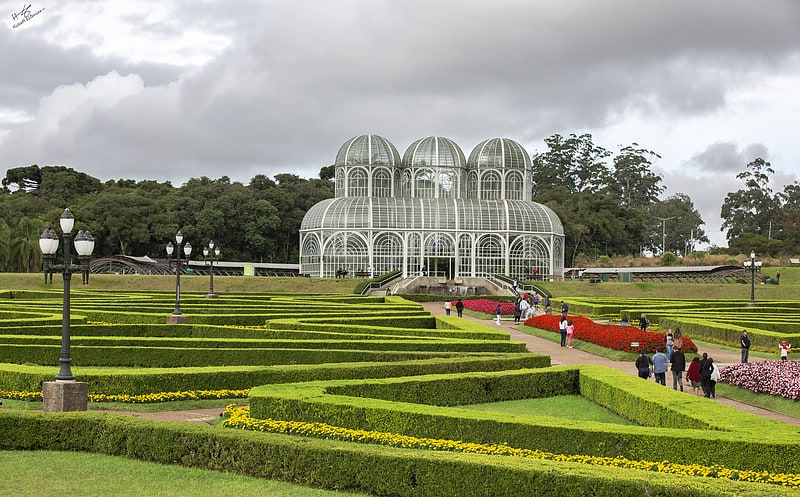
Also known as: Jardim Botânico de Curitiba
Modern garden for primarily native flora. The Jardim Botânico de Curitiba, in Portuguese, or the Botanical Garden of Curitiba, in English, also known as the "Jardim Botânico Fanchette Rischbieter", is a park located in the city of Curitiba - the capital of the state of Paraná, and the biggest city in southern Brazil. It is the major tourist attraction and landmark of the city, and it houses part of the campus of the Federal University of Paraná. The international identification code is CURIT.
Opened in 1991, Curitiba's trademark botanical garden was created in the style of French gardens. Once by the portal of entry, one may see extensive gardens in the French style amidst fountains, waterfalls and lakes, and the main greenhouse of 458 square meters, which shelters in its interior, specimens of plants characteristic of tropical regions. It rolls out its carpet of flowers to the visitors right at the entrance. The park occupies 240.000 m² in area. The principal greenhouse, in an art nouveau style with a modern metallic structure, resembles the mid-19th century Crystal Palace in London. The Botanic Museum, which provides a national reference collection of native flora, attracts researchers from all over the world. It includes many botanic species from the moist Atlantic Forests of eastern Brazil.
The native forest is filled with paths for strolling. Behind the greenhouse is the Museum of Franz Krajcberg, the Polish Brazilian artist who took up the cause of environmental conservation; with 1,320 square meters of area, divided into multimedia classrooms, an auditorium with 60 seats and lounge with several exhibitions of works donated by visual artists, represented by sculptures and reliefs, as well as photographs, videos, publications and educational materials.
In the other side of the park is the Botanical Museum, a wooden building whose main entrance is reached through a wooden bridge. The Botanical Museum of Curitiba has the fourth largest herbarium in the country. In front of the construction there is a pond with carp, turtles, herons, etc. and around the building there is a lake, an auditorium, a library, an expositions area, a theatre, tennis courts and a cycle track.[13]
Address: R. Engo. Ostoja Roguski, 80210-390 Curitiba (Regional Matriz)
Museu Oscar Niemeyer, Curitiba
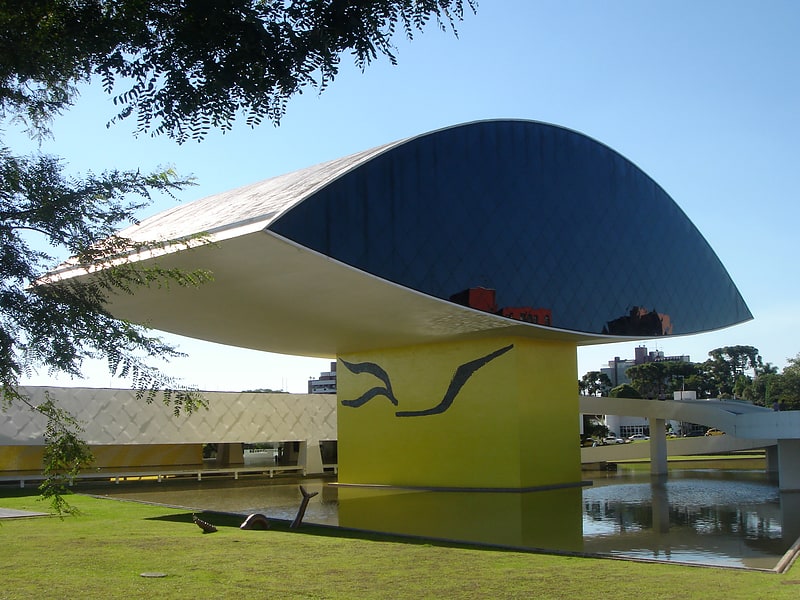
Contemporary art and design museum. The Oscar Niemeyer Museum is located in the city of Curitiba, in the state of Paraná, in Brazil. It was inaugurated in 2002 with the name Novo Museu or New Museum. With the conclusion of remodeling and the construction of a new annex, it was reinaugurated on July 8, 2003, with the current denomination to honor its famous architect who completed this project at 95 years of age. It is also known as Museu do Olho or Niemeyer's Eye, due to the design of the building.
The museum focuses on the visual arts, architecture and design. For its magnificence, beauty and for the importance of the collection, it represents a cultural institution of international significance. The complex of two buildings, installed in an area of 35 thousand square meters (of which 19 thousand are dedicated to exhibition space), it is a true example of architecture allied with art. The first building was designed by Oscar Niemeyer in 1967, faithful to the style of the time, and conceived as an educational institute, which was opened in 1978.
The museum features many of Niemeyer's signature elements: bold geometric forms, sculptural curved volumes placed prominently to contrast with rectangular volumes, sinuous ramps for pedestrians, large areas of white painted concrete, and areas with vivid murals or paintings. Though rooted in modern architecture since his involvement in the international style, Niemeyer's designs have much in common with postmodern architecture as well and this is as contemporary a building as the artwork it displays.[14]
Address: R. Mal. Hermes, 999, 80530-230 Curitiba (Regional Matriz)
Fundação Iberê Camargo, Porto Alegre
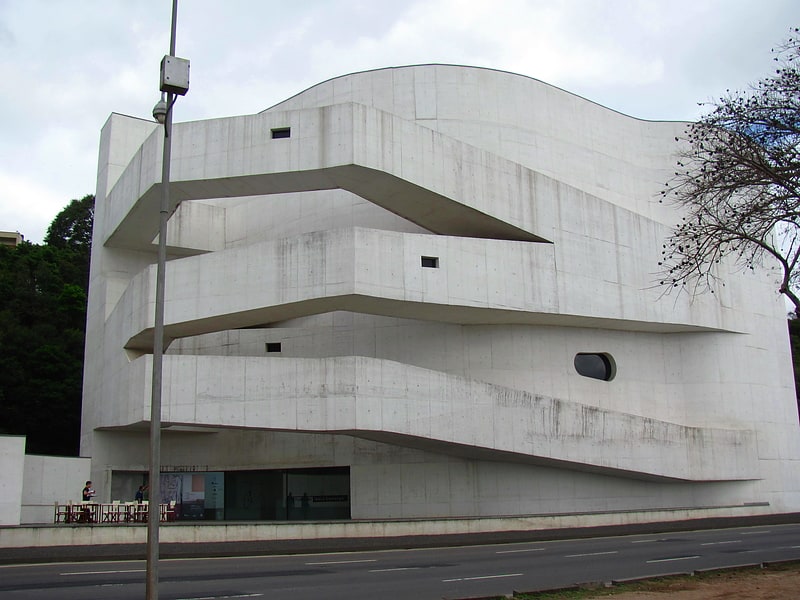
Sleek museum devoted to Iberê Camargo. The Iberê Camargo Foundation is a cultural institution and museum located in Porto Alegre, Brazil. The Foundation is dedicated to preserving and promoting the work of Brazilian painter Iberê Camargo.[15]
Address: Av. Padre Cacique, 2000, 90810-240 Porto Alegre (Centro)
Porto Alegre Public Market, Porto Alegre
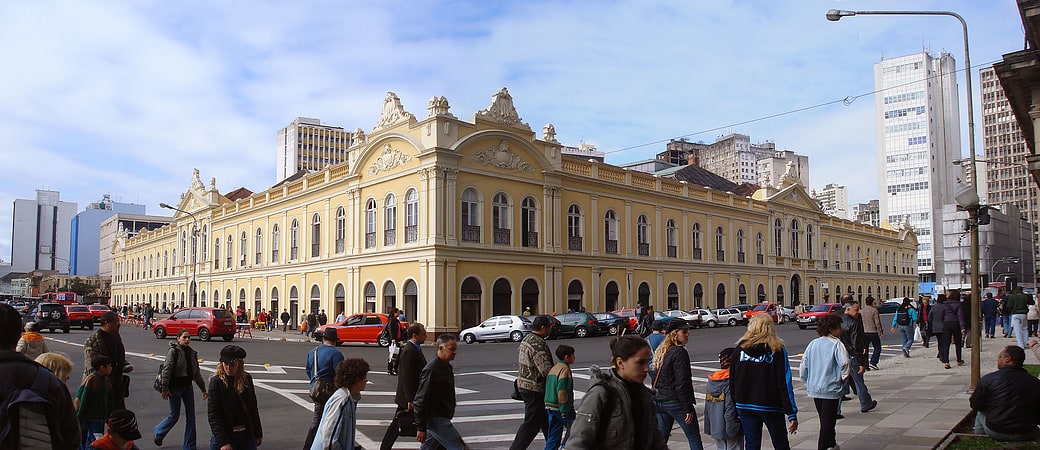
Also known as: Mercado Público de Porto Alegre
Market in Porto Alegre, Brazil. The Porto Alegre Public Market, in downtown Porto Alegre, Brazil, is the city's oldest public market. It also is an important historic landmark and a well-known meeting point, with many coffee shops and restaurants.
The cornerstone was laid on 29 August 1864, and it was constructed over an earlier and smaller market. Frederico Heydtmann designed the building, but his plan was substantially altered and enlarged. The inauguration took place on 3 October 1869. In 1886, 24 small shops were installed in the inner yard.
In 1912, while undergoing renovation, a fire destroyed all the stalls in the inner area. A second floor was added by 1913. The market suffered from a major flood in 1941, and from additional fires in 1976, 1979 and 2013. In the administration of Telmo Thompson Flores, it ran the risk of being demolished, but the outcry led to the reconsideration of the decision.
In 1990 the City administration organized a multidisciplinary team to develop a Restoration Project, which focused on the following goals:
- Rescue of the aesthetic quality of the building;
- Optimizing supply potentials;
- Creation of spaces of sociability.
The works included a modern structure of steel and glass to cover the large area of the inner yard, regained the visual perception of the inner arcades, renewed the internal circulations, created new living spaces, and deployed network infrastructure needed to handle the daily activities of a large and busy market.
The new cover allowed the integration between the ground floor and second floor. The second floor, where there were offices and public offices before, now has several popular establishments such as restaurants, snack bars, and coffee shops. With the works, the market also expanded its number of shops. The inauguration took place on 19 March 1997.
The Public Market is part of the traditions of the city, mainly for its "Banca 40" (an ice cream parlor), its centenary restaurant Gambrinus and one of the most traditional bars in town, the 101 years old Bar Naval (Navy Bar). There are about 109 shops, selling fresh produce and baked goods, locally raised meats and dairy products, and various other food items and also handcrafted goods. There are over 100,000 items for sale.
On 6 July 2013, the Public Market caught fire again. The fire is believed to have started at 20h30 on the upper floor at the corner of Avenida Borges de Medeiros and Júlio de Castilhos. Recent reports say that no people were injured, but 30% of the structure appeared to have burned down.[16]
Address: Mercado Público de Porto Alegre, 90020-070 Porto Alegre (Centro)
Imperial Museum of Brazil, Petrópolis
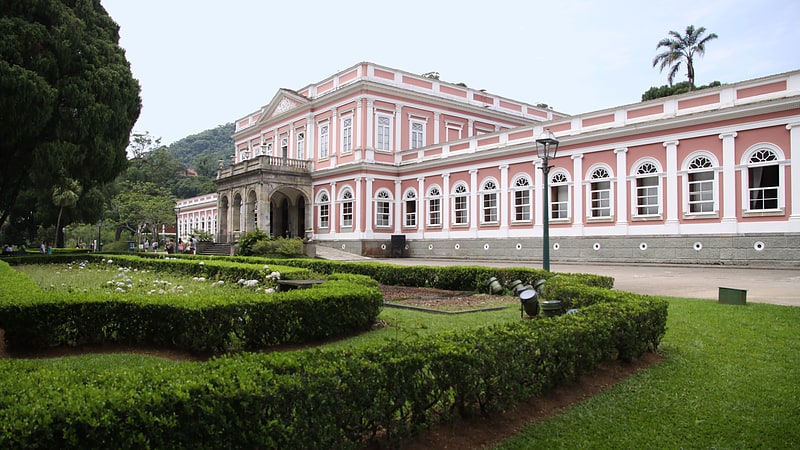
Also known as: Museu Imperial
Large museum of art and Brazilian history. The Museu Imperial de Petrópolis is a museum in the historic center of Petrópolis, Rio de Janeiro, Brazil. It is housed in the Petrópolis Imperial Palace, the former summer residence of Emperor Pedro II, which was built starting in 1845.
The museum includes the palace itself, pieces of the monarchical past of Brazil, and a temporary exhibition hall dedicated to contemporary art. It is one of the most-visited museums – and was voted the best museum – in the country.[17]
Address: R. da Imperatriz, 220, 25610-320 Petrópolis
Igreja de São Francisco de Assis, Belo Horizonte

Modern Catholic church completed in 1943. The Church of Saint Francis of Assisi is a chapel in Pampulha region of Belo Horizonte, in the state of Minas Gerais, southeastern Brazil. It was designed by the Brazilian architect Oscar Niemeyer in the organic modern style. It is the first listed modern architectural monument in Brazil and consists of four undulating concrete parabolas with outdoor mosaics. The interior hosts a mural by Candido Portinari, and the exterior features a landscape designed by Roberto Burle Marx.
The curved lines of the church enchanted artists and architects, but scandalized the city's conservative culture. Despite its completion in 1943 and Juscelino Kubitschek's call for its consecration, the church was not consecrated until 1959. For 14 years, the ecclesiastical authorities, led by Antonio dos Santos Cabral, prohibited the chapel from providing Catholic services.
As of July 2016, the church is classified as a UNESCO World Heritage Site, part of the Pampulha Modern Ensemble, a collection of Niemeyer buildings in Pampulha.[18]
Address: Av. Otacílio Negrão de Lima, 3000, 31555-200 Belo Horizonte (Pampulha)
Autódromo Internacional de Curitiba, Curitiba
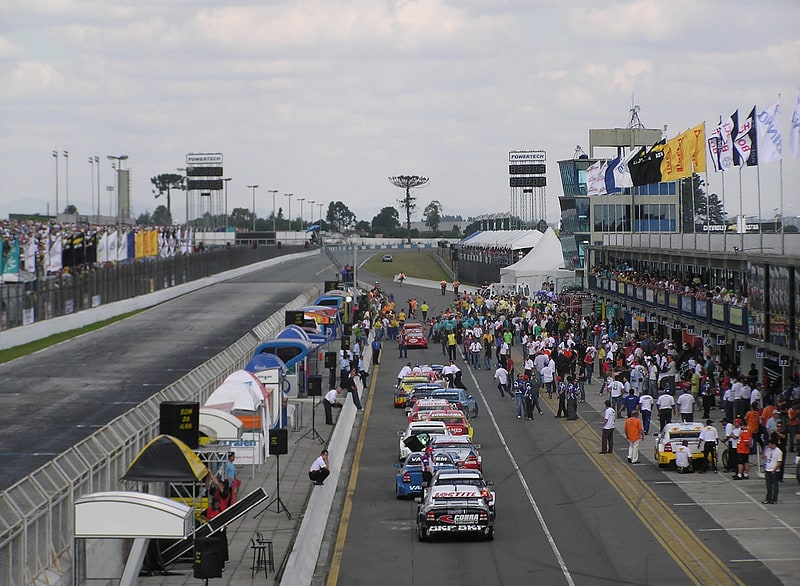
Car racing track in Pinhais, Brazil. Autódromo Internacional de Curitiba was a motorsports circuit located in Pinhais, Brazil. It has been host to the World Touring Car Championship, TC2000, Fórmula Truck and Stock Car Brasil racing. Until 2013 the circuit has also been host of the South American Formula 3 Series, namely the Formula 3 Sudamericana. The circuit also formerly hosted the Brazilian Formula Three Championship.
The circuit also hosted the "Festival Brasileiro de Arrancada", from 1992 to 2016, which was the biggest drag racing event in Latin America.[19]
Address: Avenida Irai 16, 83321-000 Pinhais
MARGS, Porto Alegre
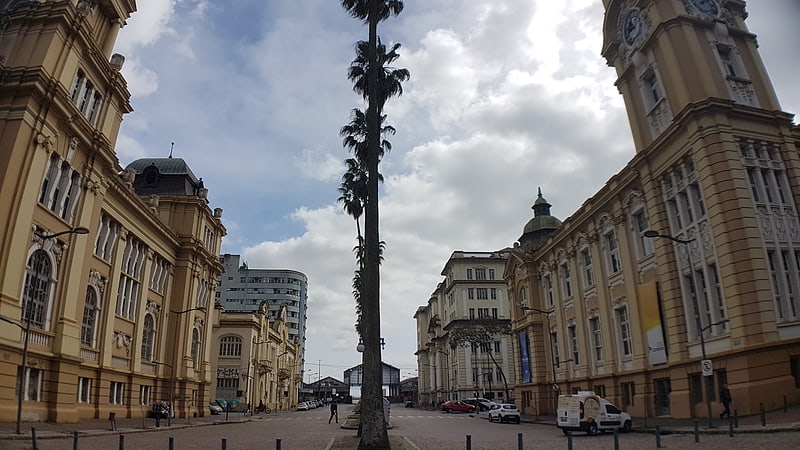
Also known as: Museu de Arte do Rio Grande do Sul Ado Malagoli
Museum in Porto Alegre, Brazil. The Rio Grande do Sul Museum of Art is an art museum in the State of Rio Grande do Sul. It is located in the centre of Porto Alegre. Its eclectic building, national heritage, is one of the most noteworthy historic buildings in Porto Alegre. Its design is usually attributed to Theodor Wiederspahn, a German-Brazilian architect, although important local historian and artist Fernando Corona ascribes it to Germano Gundlach.[20]
Address: Praça da Alfândega, 90010-210 Porto Alegre (Centro)
Caracol Falls, Canela
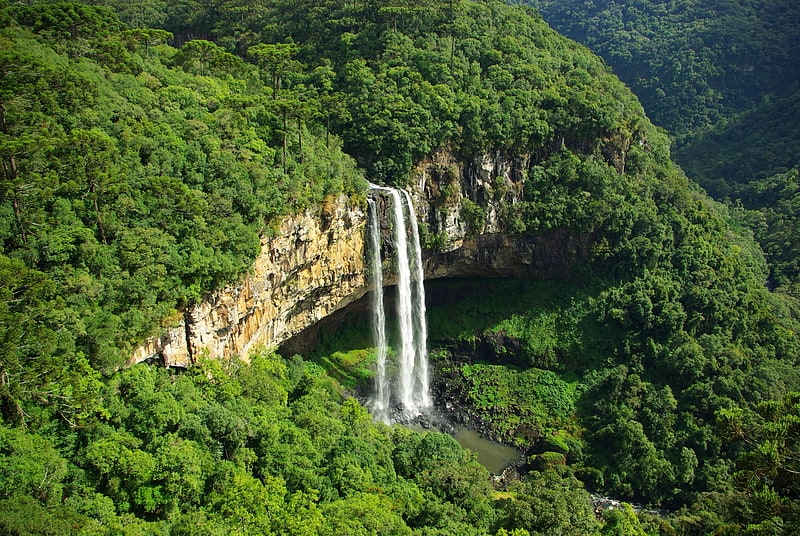
Also known as: Cascata do Caracol
Towering waterfall on basalt rock cliffs. Caracol Falls or Cascata do Caracol, is a 426-foot waterfall about 4.35 miles from Canela, Brazil in Caracol State Park. It is formed by the Caracol River and cuts out of basalt cliffs in the Serra Geral mountain range, falling into the Vale da Lageana. The falls are situated between the pinheiral zone of the Brazilian Highlands and the southern coastal Atlantic Forest. The base of the waterfall can be reached by a steep 927-step trail maintained by the Projeto Lobo-Guará.
Waterfall has formed on the basalt rocks of Serra Geral formation and has two cascades. Upper cascade is located approximately 100 m before the second cascade, which falls over an overhanging cliff ledge.
Caracol Falls has long attracted visitors and is the second most popular natural tourist attraction in Brazil, trailing only Iguazu Falls. In 2009, it received more than 289,000 visitors. There is a nearby 100-foot observation tower that offers an elevator and a panoramic view, as well as a cable car that gives tourists an aerial view of the waterfall.
The area also provides a restaurant and craft stalls.[21]
Address: Estrada Rs 466, 95680-000 Canela
Fortaleza de São José da Ponta Grossa, Florianopolis
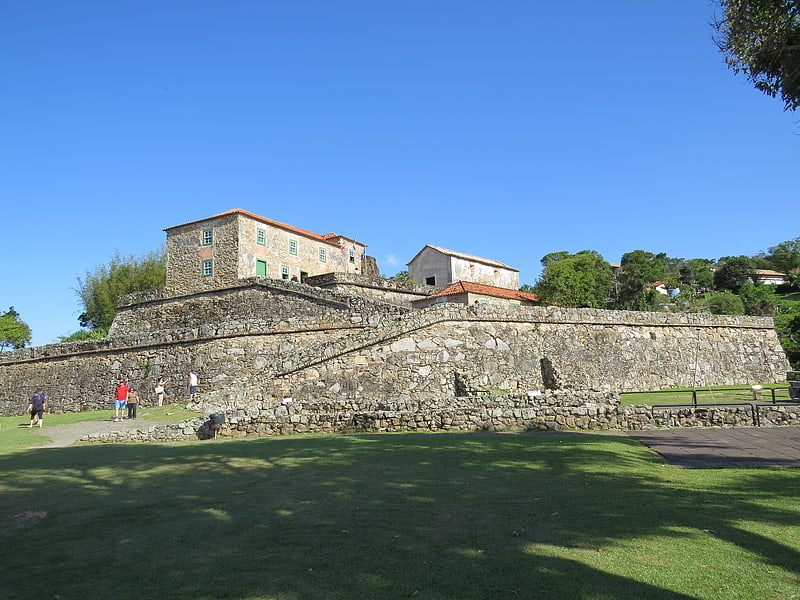
Fortress in Florianópolis, Brazil. Fortaleza de São José da Ponta Grossa is a fort located on the northern end of Santa Catarina Island in the municipality of Florianópolis, capital of Santa Catarina state, in southern Brazil.[22]
Address: Servidão da Carioca, s/n, 88010-000 Florianópolis
Hercilio Luz Bridge, Florianopolis
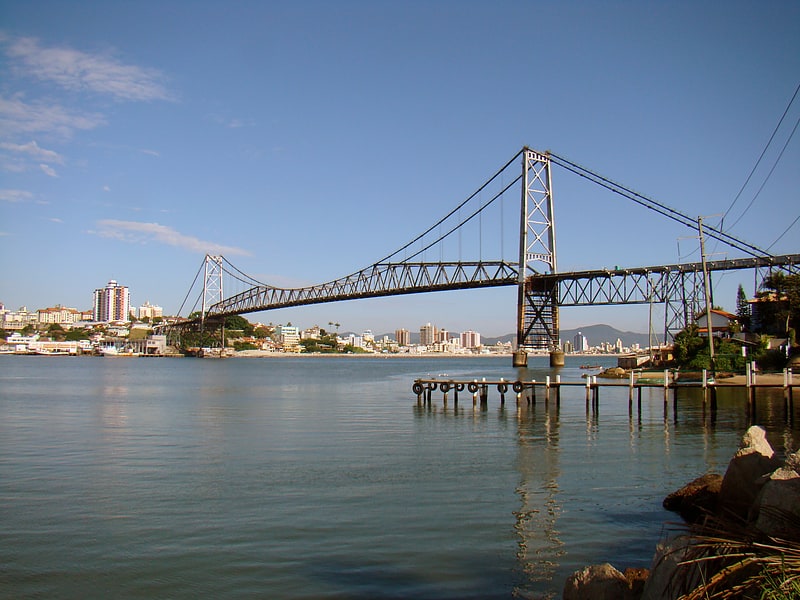
Also known as: Ponte Hercílio Luz
Brazil's longest suspension bridge. The Hercílio Luz Bridge, located in Florianópolis, the capital city of Santa Catarina State in southern Brazil, is the first bridge constructed to link the Island of Santa Catarina to the mainland.
It is the longest suspension bridge in Brazil. The central span was considered quite long (but not the longest, at 340 metres) at the time of its opening and is still one of the 100 largest suspension bridges.
Construction commenced on 14 November 1922 with the bridge being inaugurated on May 13, 1926. The total length is 819.471 metres, with 259 metres of viaduct from the island, a central span of 339.471 metres and 221 metres of viaduct from the mainland.
It was closed to the public on May 13, 1991 and reopened after complete restoration on December 30, 2019.[23]
Forte dos Reis Magos, Natal
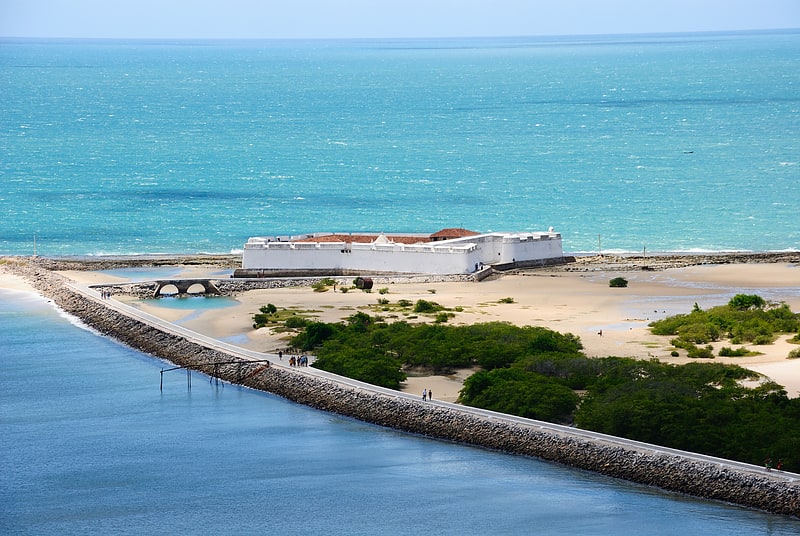
Tourist attraction in Brazil. The Forte dos Reis Magos or Fortaleza dos Reis Magos, is a fortress located in the city of Natal in the Brazilian state of Rio Grande do Norte.
The fortress was the first milestone of the city - founded on 25 December 1599 - on the right side of the bar of the Potengi River (today near the Newton Navarro bridge). It received its name based on the date of commencement of its construction, 6 January 1598, at Epiphany Catholic calendar.[24]
Address: Av. Praia do Forte, s/n, 59010-000 Natal (Zona Leste)
Cathedral of Petrópolis, Petrópolis
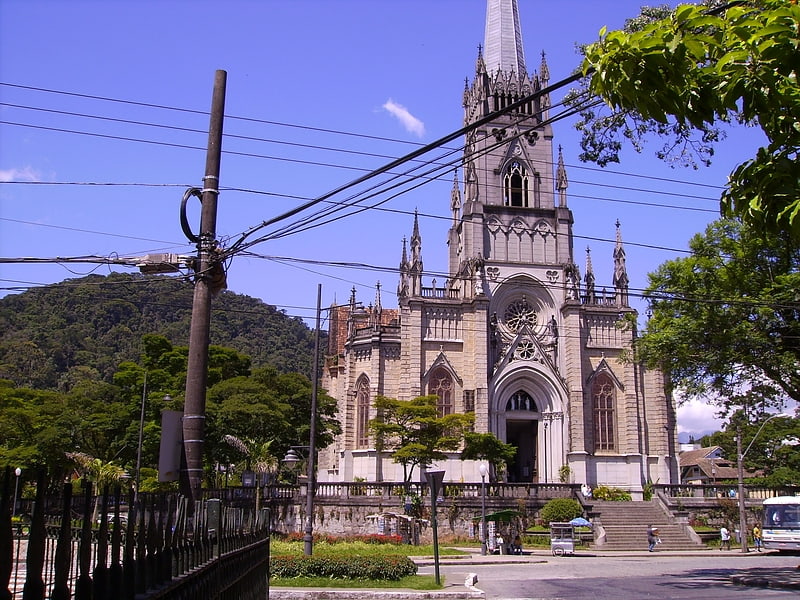
Also known as: Catedral de Petrópolis
Gothic cathedral and Dom Pedro II's tomb. The Cathedral of Saint Peter of Alcantara, also known as the Cathedral of Petrópolis, is a Roman Catholic cathedral in Petrópolis, Brazil, dedicated to the city's patron saint, Peter of Alcantara. The cathedral is also the resting place of the last Emperor of Brazil, Dom Pedro II, and his family.
The construction on the Gothic Revival style church began in 1884, and was completed in 1925. The church tower was built in 1969.[25]
Address: R. S. Pedro de Alcântara, 60, 25685-300 Petrópolis
Niterói Contemporary Art Museum, Niterói
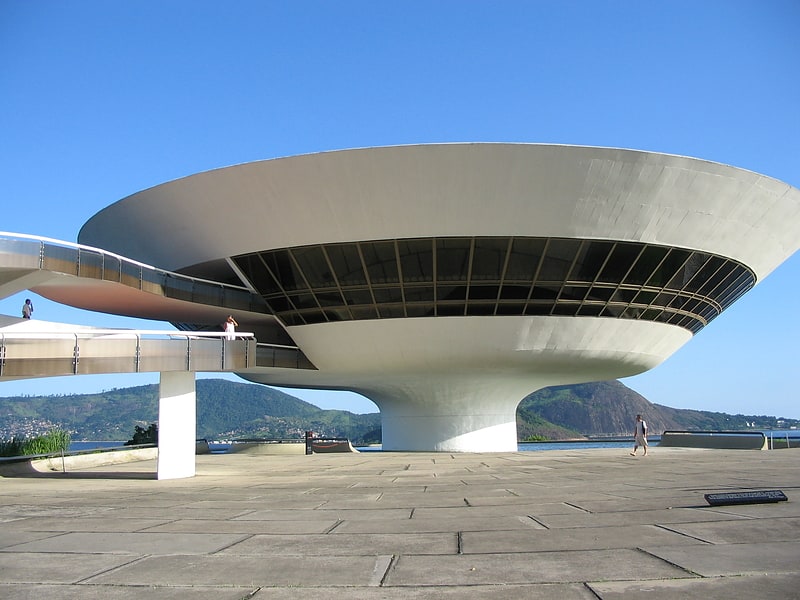
Also known as: Museu de Arte Contemporânea de Niterói
Iconic architecture and modern art. The Niterói Contemporary Art Museum is situated in the city of Niterói, Rio de Janeiro, Brazil, and is one of the city’s main landmarks. It was completed in 1996.
The MAC-Niterói was designed by Oscar Niemeyer with the assistance of structural engineer Bruno Contarini, who had worked with Niemeyer on earlier projects. The structure is 16 meters high; its cupola has a diameter of 50 meters with three floors. The museum has a collection of 1,217 works from the art collector João Sattamini. The collection was assembled since the 1950s by Sattamini, constituting the second largest collection of contemporary art in Brazil.
The museum projects itself over Boa Viagem (“Bon Voyage,” “Good Journey”) beach and also a neighborhood, the 817 square metres (8,790 sq ft) reflecting pool that surrounds the cylindrical base “like a flower,” in the words of Niemeyer.
A wide access slope leads to a Hall of Expositions, which has a capacity for sixty people. Two doors lead to the viewing gallery, through which can be seen Guanabara Bay, Rio de Janeiro, and Sugarloaf Mountain. The saucer-shaped modernist structure, which has been likened to a UFO, is set on a cliffside, at the bottom of which is a beach. In the film Oscar Niemeyer, an architect committed to his century, Niemeyer is seen flying over Rio de Janeiro in a UFO which then lands on the site, suggesting this to be the origin of the museum.[26]
Address: Mirante da Boa Viagem, s/nº, 24210-390 Niterói (Praias da Baía)
Ver-o-peso, Belém
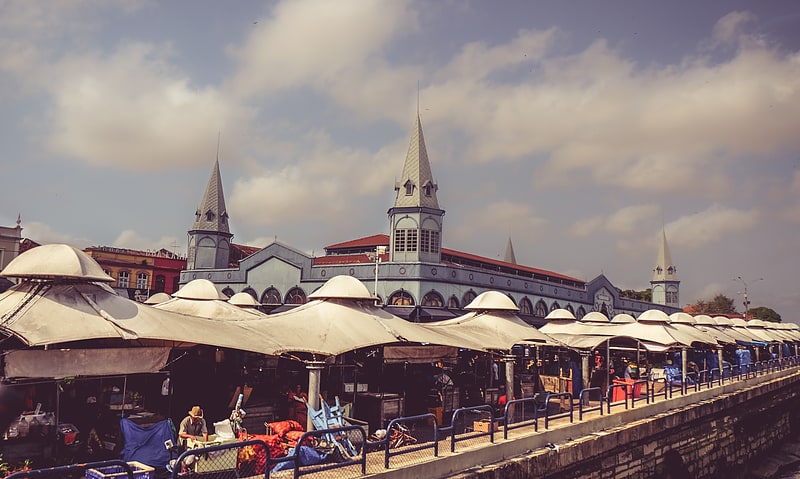
Also known as: Mercado Ver-o-Peso
Wholesale market in Belém, Brazil. Ver-o-peso market is a market hall in Belém, Brazil located at Guajará Bay riverside.
It is called "Ver-o-Peso" following a colonial era tradition, since the tax collector's main post was located there, which was called "Casa do Haver-o-peso". It was in the "Haver-o-peso house" that the taxes over goods brought from the Amazon forests, rivers and countryside should be paid to the Portuguese crown, but only after their weight was measured, hence the name, which later suffered a contraction.
Nowadays, the Ver-o-peso complex contains the Açaí Fair, a free open market where açaí berry merchants sell the fruit in natura for açaí juice shops, the Clock Square, with an iron-cast clock tower brought from England, the Ver-o-peso docks, where native fishes from Amazon are unloaded from boats and sold fresh, the Iron Market, a gothic prefab structure where fish is sold, the Solar da Beira space, a colonial building where art expositions often take place, and the neoclassical Meat Market, across the street, with iron-cast stairs and cubicles. There's also the free market, where craftsmanship, natural essence parfums, typical food and native fruits are sold.
It is located a few meters away from Feliz Lusitânia complex, a gathering of 16th and 18th century buildings including a fortress, an old hospital transformed into a museum, and two churches: a baroque one where there is a sacred art museum, and Belém's cathedral.
All this area has been declared national patrimony by the National Historical Museum. Around ten years ago, Ver-o-peso was bidding a place into UNESCO's list of world's human patrimonies, but it wasn't included and since then the City never tried again.[27]
Address: Boulevard Castilhos Franca 1040, 66010-020 Belem (Dabel)
Arena das Dunas, Natal
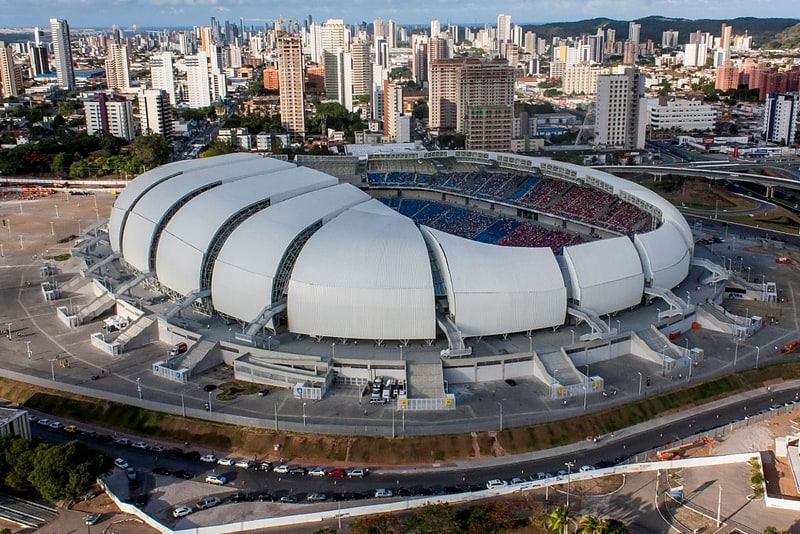
Stadium in Natal, Brazil. The Arena das Dunas is a football stadium in Natal, Brazil. The arena can shelter 31,375 spectators, and was designed by sports architect Christopher Lee of Populous. The stadium hosted football matches for the 2014 FIFA World Cup held in Brazil. During the tournament, it had a seating capacity of 42,000. It was built in place of the Machadão, which was demolished in 2011.
This project replaced an old project called "Estádio Estrela dos Reis Magos" that would have been located in the neighboring municipality of Parnamirim. In the new project, a shopping center and commercial buildings, hotels of international standard and an artificial lake around the stadium will be built.
The stadium is located by the Senador Salgado Filho Avenue (BR-101 highway), a multi-lane road already served by the Complexo Viário do Quarto Centenário (Fourth Centennial Complex road or Complexo Viário Senador Carlos Alberto de Sousa). The project was one of the most praised by inspectors from FIFA.[28]
Address: Avenida Prudente de Morais 5121, 59064-625 Natal (Zona Sul)
Palácio Rio Negro, Petrópolis
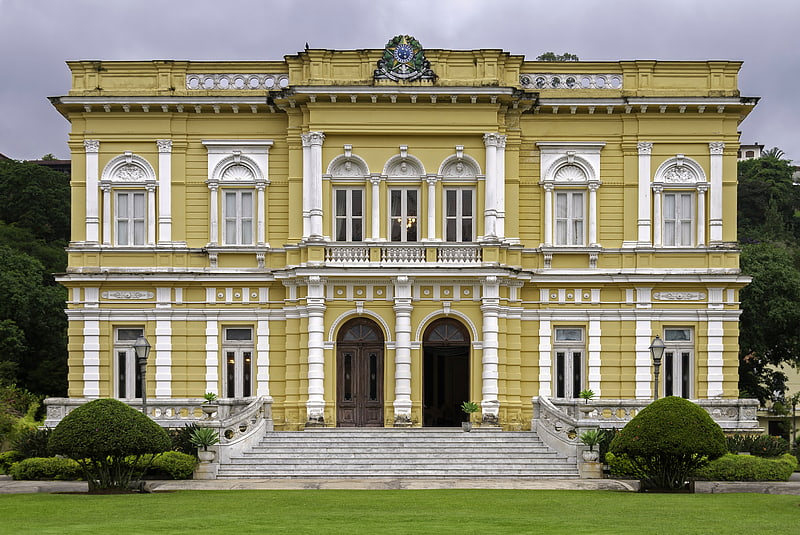
The Palácio Rio Negro is a palace located in Petrópolis, mountainous region of the state of Rio de Janeiro, Brazil. It is one of the official residences of the President of Brazil, used mainly as a country retreat.[29]
Address: Av. Koeller, 255, 25688-900 Petrópolis
Praça Sete de Setembro, Belo Horizonte
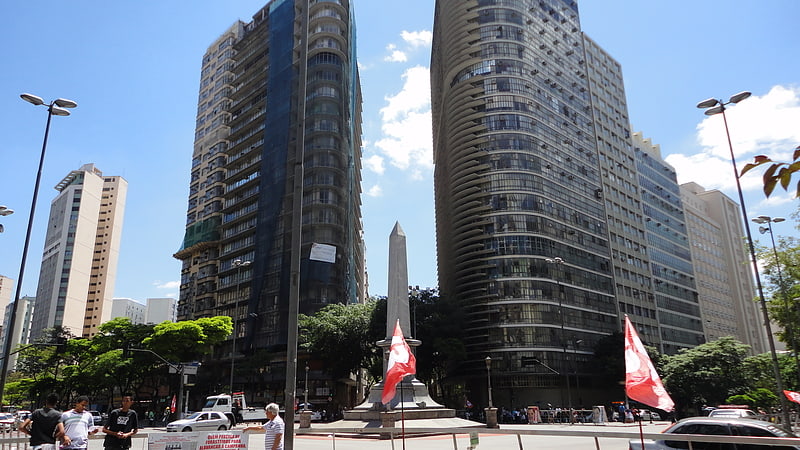
Historical landmark in Belo Horizonte, Brazil. Praça Sete de Setembro normally called Praça Sete, is a square inside Belo Horizonte, Minas Gerais, Brazil, in the center of the city's downtown. It's located at the intersection of two major avenues, Afonso Pena and Amazonas, and by the streets Rio de Janeiro and Carijós.
It boasts an obelisk at its center donated by the people of the neighboring Capela Nova do Betim, today the city of Betim, the inhabitants of the state capital, on the occasion of the commemoration of the centenary of the Independence of Brazil, on September 7, 1822. The "Lollipop", as it is known, is made of granite and formed by a 7m needle supported over a square pedestal adorned by a pole in each of its vertices. It was designed by architect Antonio Rego and built by engineer Antonio Gonçalves Gravatá. history.[30]
Our Lady of Exile and St. Catherine of Alexandria Cathedral, Florianopolis
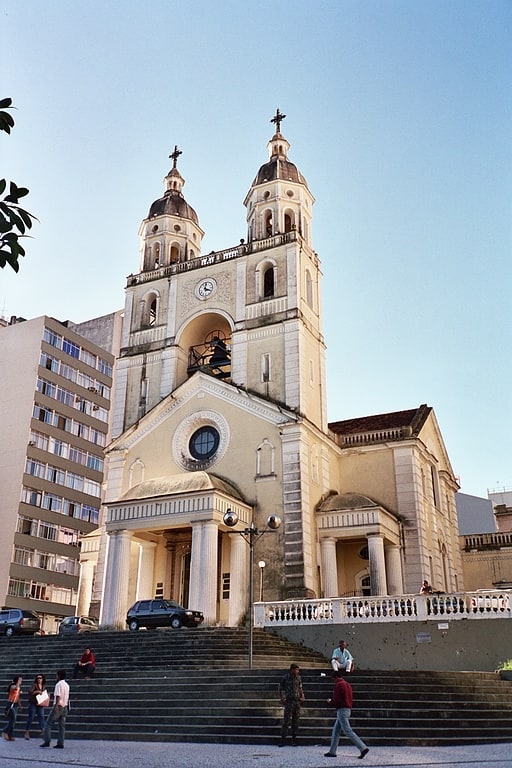
Also known as: Catedral Metropolitana de Florianópolis
Store in Florianópolis, Brazil. The Our Lady of Exile and St. Catherine of Alexandria Cathedral Also Florianópolis Cathedral It is a Catholic church dedicated to Our Lady of the Exile, which functions as the cathedral of the archdiocese of Florianópolis, since its creation on March 19, 1908. The building is protected by the National Historical and Artistic Heritage Institute of Brazil.
The definitive colonization of Florianópolis began in 1673. In 1679, Francisco Dias Velho required the legal title of the lands, beginning the construction of a church dedicated to the Virgin Mary. It was small and built with limestone. Inside it, the founder of Desterro (today Florianópolis) was assassinated. In 1908 it was elevated to the condition of Cathedral.[31]
Address: R. Pe. Miguelinho, 55, 88010-550 Florianópolis
Parque das Aves, Foz do Iguaçu
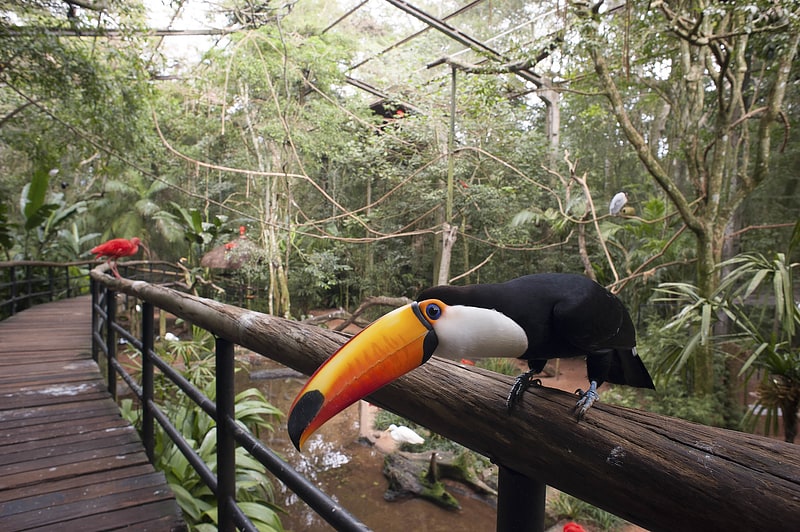
Zoo with birds, reptiles and butterflies. The Parque das Aves is a sanctuary and shelter for birds situated in Foz do Iguaçu, Paraná State, Brazil, and it is near to Iguaçu Falls. Its exhibits comprise mainly birds as well as other animals and butterflies.
The park was opened in 1994 and it is set within 16 hectares (40 acres) of forest.[32]
Address: Rodovia das Cataratas, 12450, 85855-750 Foz do Iguacu
Casa Kubitschek, Belo Horizonte
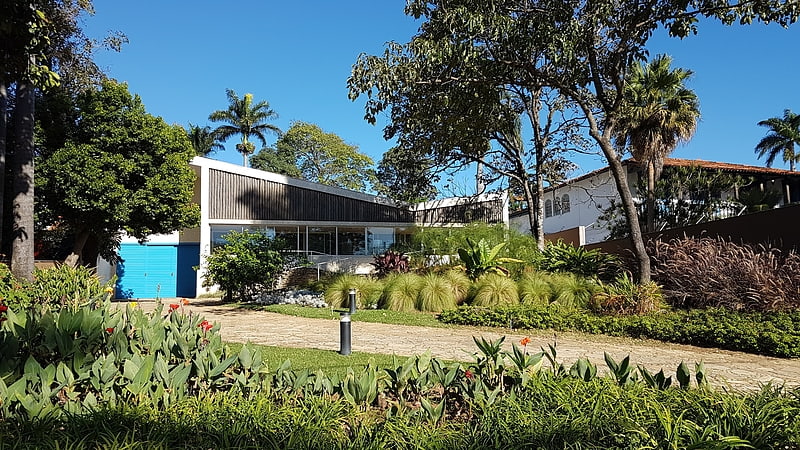
The Kubitschek Residence Museum is a museum house located on the shore of Lake Pampulha in Belo Horizonte, Minas Gerais, Brazil. The building served as the weekend residence of Juscelino Kubitshek, prefect of Belo Horizonte at the time.[33]
Address: Avenida Otacilio Negrao de Lima 4188, 31340-505 Belo Horizonte (Pampulha)
Amazon Theatre, Manaus
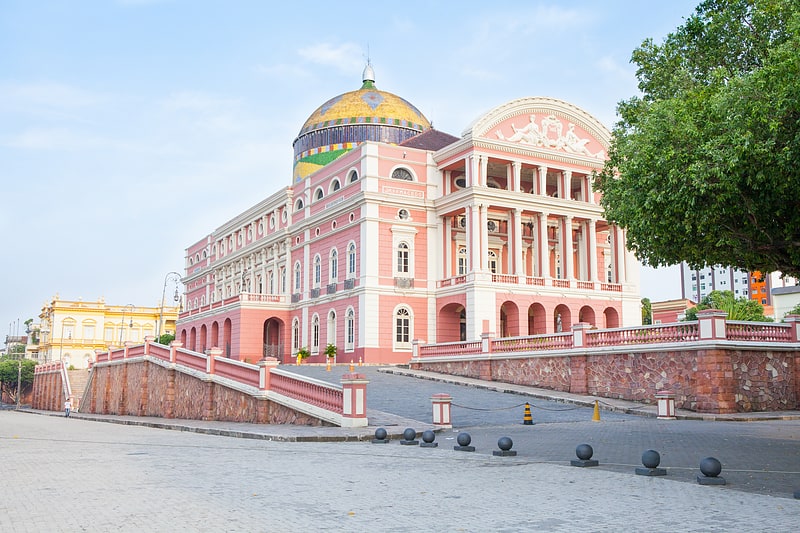
Also known as: Teatro Amazonas
Opera house in Manaus, Brazil. The Amazon Theatre is an opera house located in Manaus, in the heart of the Amazon rainforest in Brazil. It is the location of the annual Festival Amazonas de Ópera and the home of the Amazonas Philharmonic Orchestra which regularly rehearses and performs at the Amazon Theatre along with choirs, musical concerts and other performances.
More than 120 years old, it represents the city's heyday during the rubber boom. It was chosen by the magazine Vogue as one of the most beautiful opera houses in the world.[34]
Address: Manaus, Eduardo Ribeiro Avenue, Centro
Museu Paraense Emílio Goeldi, Belém
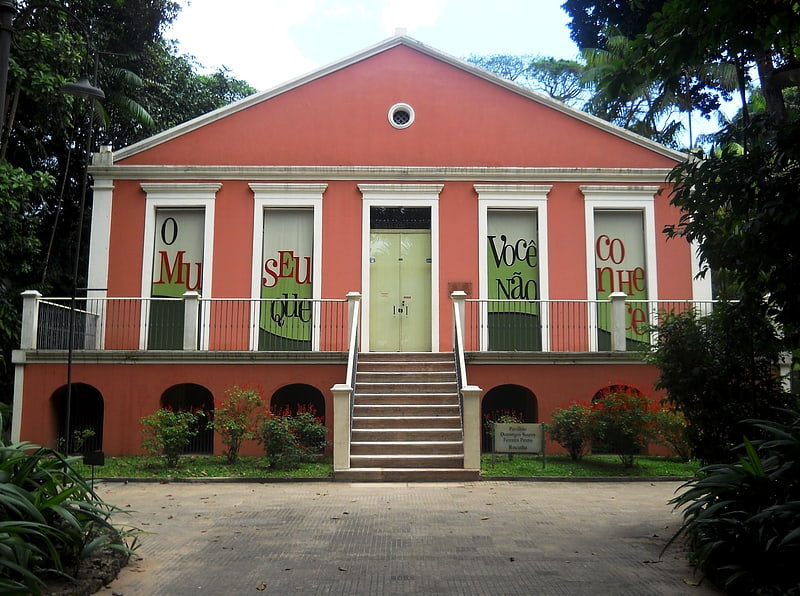
Also known as: Museu Goeldi
Long-running museum of natural sciences. The Museu Paraense Emílio Goeldi is a Brazilian research institution and museum located in the city of Belém, state of Pará. It was founded in 1866 by Domingos Soares Ferreira Penna as the Pará Museum of Natural History and Ethnography, and was later named in honor of Swiss naturalist Émil August Goeldi, who reorganized the institution and was its director from 1894 to 1905. It is open to the public from 9:00 to 17:00 h, daily except Mondays.[35]
Address: Avenida Magalhaes Barata 376, 66630-040 Belem (Dabel)
Mercado Municipal Adolpho Lisboa, Manaus

Market in Manaus, Brazil. The Mercado Adolpho Lisboa, also called Mercado Municipal or Mercadão, is a marketplace located in Manaus, Brazil. It lies on the shore of the Rio Negro. The market was constructed between 1880 and 1883. The building was based on the Les Halles marketplace of Paris, France. The building's metallic structures were built in Paris and sent to Manaus by ship. Has two completely different facades, one facing the Rio Negro and one facing the public road. Is an important historical and architectural building of the city, the Municipal Market also stands out today as a cultural and tourist center. The market is one of the largest open markets in the city of Manaus, offering fresh fruits, spices, fish, souvenirs, traditional indigenous medications and among other products. The building was interdicted in 2006 for restoration works and was delivered after seven years on October 23, 2013.[36]
Address: R. dos Barés, 46, Centro, 69005-020 Manaus (Zona Sul)
Ponte Newton Navarro, Natal
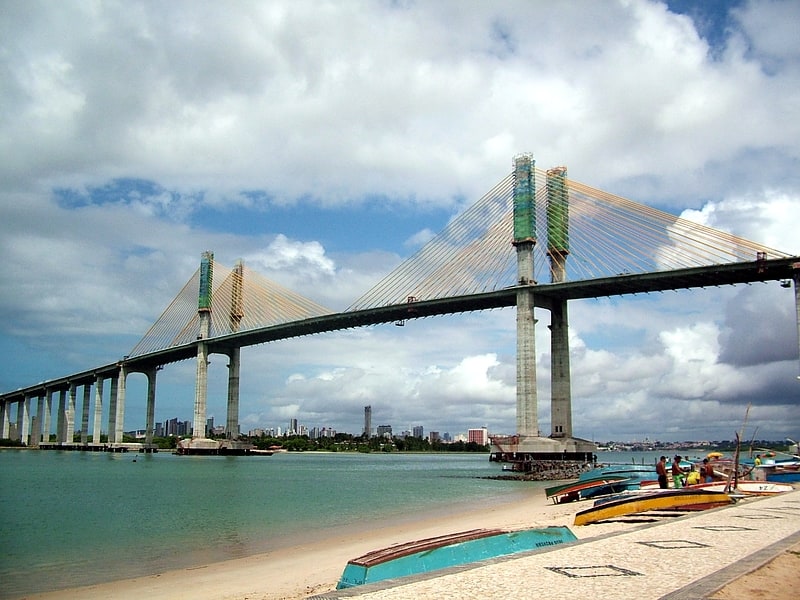
Cable-stayed bridge in Natal, Brazil. The Newton Navarro Bridge, is one of the biggest cable-stayed bridges in Brazil. It is located in the city of Natal, the capital of the Brazilian state of Rio Grande do Norte. It connects North Zone and the cities of the north coast to the South Zone and the other regions of the city that cross the Potengi River.
The main purpose is to ease the usual heavy traffic on Igapó Bridge and to improve access to the future Greater Natal International Airport and its adjacent areas. It also increases the flow of tourism on the north coast and improves access to the inhabitants of the North Zone to the downtown and the main zones.
It is named upon Newton Navarro, an important local artist.
Also referred to as the Forte-Redinha Bridge, The main cable-stayed bridge is a prestressed concrete structure with a double plane of stay cables and conceived as an integral framed structure between the expansion joints. Piers, towers, deck main girders and stay cables lay in two parallel planes. Piers and towers are box concrete sections; main girders of deck are solid section. All construction is concreted in situ.
The approach viaducts have double columns piers while the deck is made of parallel simply supported precast girders with 40-meter spans.
Region Daily Traffic
The assistant secretary for Transport in Natal, Walter Pedro, explains that the construction of a new bridge over the Potengi is under study, connecting Baldo in the East zone to Av. Itapetinga in the North zone. Currently, on weekdays, the flow on the Igapó Bridge exceeds 70,000 vehicles, while the Newton Navarro Bridge receives an average of 39,000/day. Walter Pedro assesses the situation in Igapó as saturated, and adds that in another decade Newton Navarro will reach the limit of 60 thousand vehicles per day.[37]
Address: Pt. Newton Navarro, Natal (Zona Norte)
Santa Isabel Theater, Recife
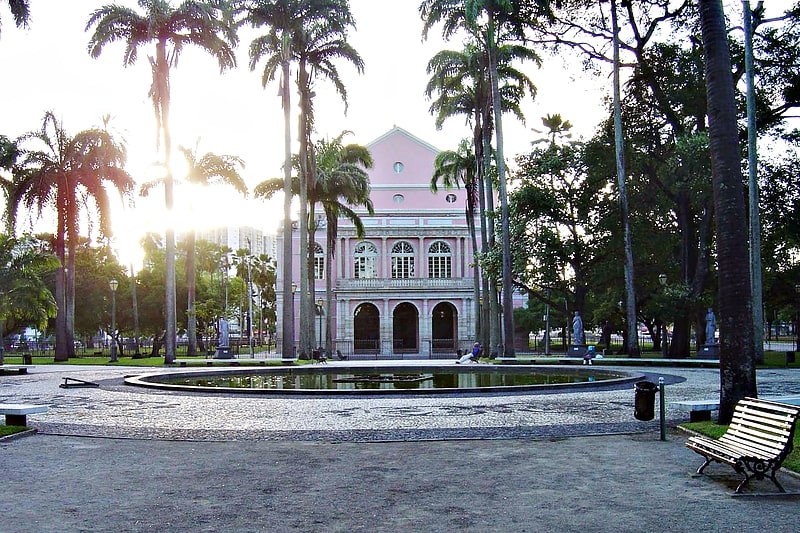
Also known as: Teatro de Santa Isabel
Theater in Recife, Brazil. Santa Isabel Theater is located in the Brazilian city of Recife, capital of Pernambuco state.
It was inaugurated on 18 May 1850, and seats 850 in the audience. It was named in honor of Princess Isabel of Braganza. Important artistic and political figures passed through the theater in the nineteenth century, including Castro Alves, Joaquim Nabuco and Emperor Pedro II of Brazil.
The theater is located in Republic Square (Praça da República) in the district of Santo Antônio. It is adjacent to the Princesses Field Palace (residency of Pernambuco state governors) and the Pernambuco Justice Palace. The theater houses the Recife Symphony Orchestra.[38]
Address: Praça da República s/n - Santo Antônio, 50010-040 Recife (RPA1)
Church of São Francisco de Assis, Ouro Preto

Also known as: Igreja de São Francisco de Assis
Baroque church with interior artworks. The Church of São Francisco de Assis is a Rococo Catholic church in Ouro Preto, Brazil.
Its erection began in 1766 after a design by the Brazilian architect and sculptor Antônio Francisco Lisboa, otherwise known as Aleijadinho. Lisboa designed both the structure of the church and the carved decorations on the interior, which were only finished towards the end of the 19th century. The circular bell towers and the oculus closed by a relief were original features in religious architecture of that time in Brazil. The façade has a single entrance door under a soapstone frontispiece under a relief depicting Saint Francis receiving the stigmata. The interior is richly decorated with golden woodwork, statues and paintings, and the wooden ceiling displays a painting by Manuel da Costa Ataíde.
Due to its architecture and historical significance regarding eighteenth-century gold mining, the church is classified on the UNESCO World Heritage List. It is one of the Seven Wonders of Portuguese Origin in the World.[39]
Address: Largo de Coimbra, 35400-000 Ouro Preto
Cathedral of Our Lady of Lourdes, Canela
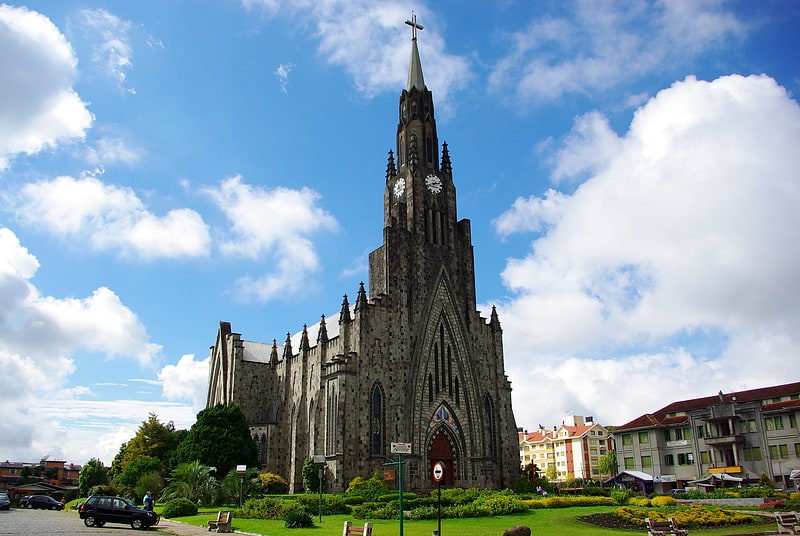
Also known as: Catedral de Pedra
Catholic church in Canela, Brazil. The Cathedral of Our Lady of Lourdes, also known as Cathedral of Stone, is a Catholic church located in the Brazilian city of Canela, Rio Grande do Sul. It is considered one of the major tourist attractions of the Serra Gaúcha.
Its characteristic style is English Gothic. The church has a tower with 65 meters high, and a carillon of 12 bells made of bronze by foundry Giacomo Crespi, Italy. In its interior are three panels consisting of painted canvases by the gaucho artist Marciano Schmitz, depicting the "Apparition of Our Lady", the "Allegory of the Angels", and "Annunciation". The paintings of Via Sacra were made by Pablo Herrera, a Uruguayan sculptor and restorer of Sacred Art. Wood and clay were used, with the background painting having superimposed images in clay.
Its stained glasses represent the litany of Our Lady. The altar, whose theme is the Last Supper, is a work of art carved in by wood Julius Tixe, a Uruguayan sculptor.[40]
Address: Praca da Matriz 69, 95680-000 Canela
Ricardo Brennand Institute, Recife
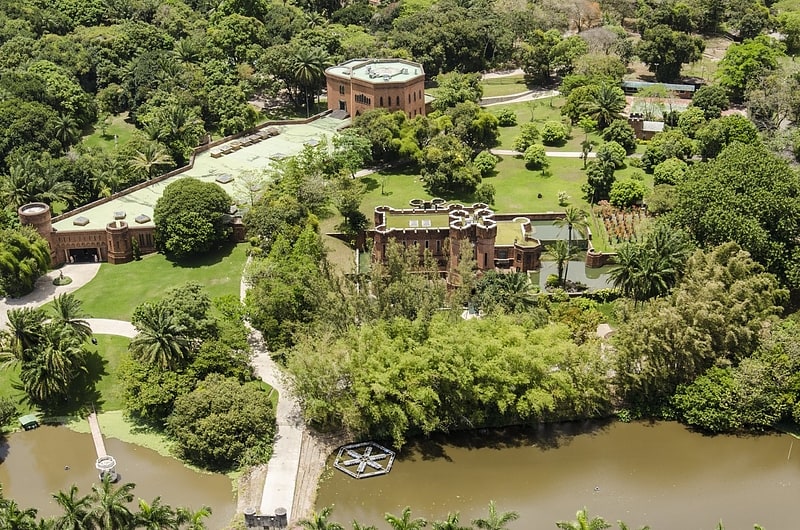
Also known as: Instituto Ricardo Brennand
Stately place for art and history exhibits. The Ricardo Brennand Institute is a cultural institution located in the city of Recife, Brazil. It is a not-for-profit private organization, inaugurated in 2002 by the Brazilian collector and businessman Ricardo Brennand. It comprises a museum, an art gallery, a library and a large park.
The Institute holds a permanent collection of historic and artistic objects of diversified provenience, ranging from Early Middle Ages to 20th century, with strong emphasis in objects, documents and artwork related to Colonial and Dutch Brazil, including the world's largest assemblage of paintings by Frans Post.
The Institute also houses one of the largest collections of armory in the world, with 3,000 pieces, the majority of which were produced in Europe and Asia between the 14th and 19th centuries. The library has over 62 thousand volumes, ranging from 16th to 20th century, including a collection of brasiliana and other rare items.[41]
St. Joseph's Cathedral, Fortaleza
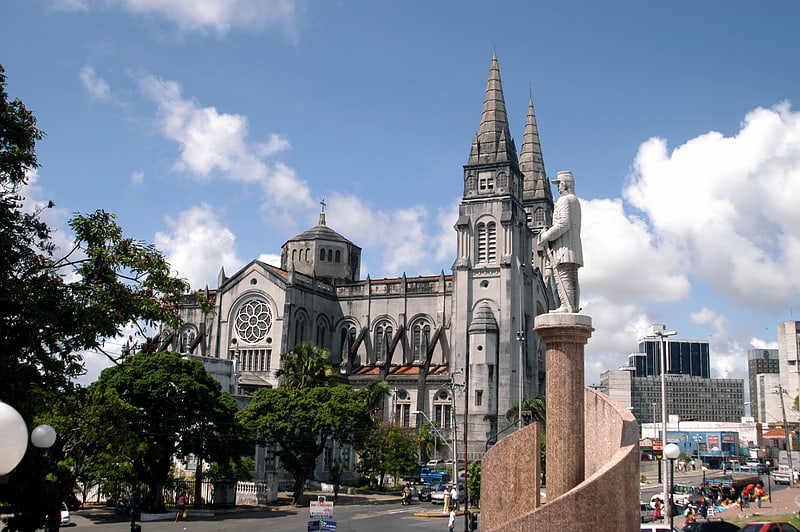
Also known as: Catedral Metropolitana de Fortaleza
Catholic cathedral in Fortaleza, Brazil. The St. Joseph's Cathedral also called Metropolitan Cathedral of St. Joseph is a Catholic church, home of the Archdiocese of Fortaleza, located in Fortaleza in Brazil. The present church was built on the site of the old church.
It took to complete the work forty years beginning in 1938 and was inaugurated in 1978. It can accommodate five thousand people and its towers reach 75 meters high. French architect George Maunier signed the draft eclectic style with a predominance of neo-Gothic, with references to the Cologne Cathedral in Germany and very similar to the Chartres Cathedral in France. Sao Jose is the Saint linked to the cathedral which is also known as the Metropolitan Cathedral of Fortaleza.[42]
Address: Praça da Sé, s/n, 60055-150 Fortaleza (Regional II)
Church of Our Lady of the Conception of the Military, Recife

The Church of Our Lady of the Conception of the Military is an 18th-century Roman Catholic church in Recife, Pernambuco, Brazil. It is located on Rua Nova in the historic center of Recife and is under the administration of the Roman Catholic Archdiocese of Olinda e Recife. The church was listed as a historic structure by the National Historic and Artistic Heritage Institute in 1941.[43]
Address: Rua Nova, 309, Santo Antônio (Centro), Recife (RPA1)
Mesquita Omar Ibn Al-Khatab, Foz do Iguaçu
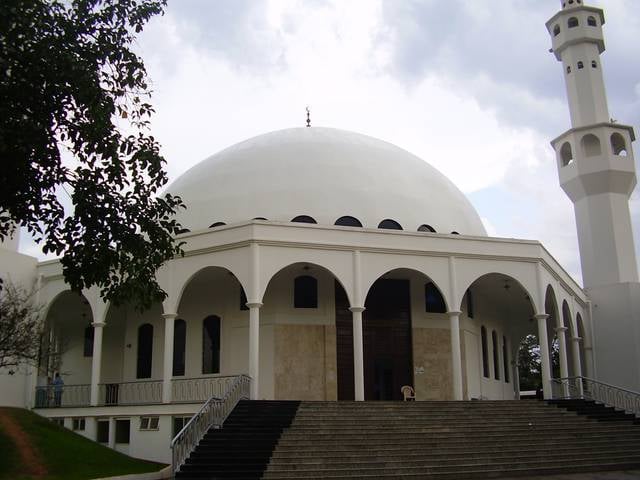
Mosque. The Omar Ibn Al-Khatab Mosque is a mosque located at Foz do Iguaçu, Paraná, Brazil. It is situated in the city near the Iguaçu Falls.
The mosque was inaugurated on 23 March 1983 featuring a beautiful exterior design painted in uniform white color. Its architecture was inspired by Al-Aqsa Mosque, in Jerusalem. The mosque is named after Omar Ibn Al-Khatab a pious companion of the Islamic prophet Muhammad. Outside the mosque are tall two minaret towers from which the Muslim call to prayer (Adaan) is sounded five times each day which gathers the faithful for congregational prayers in the spacious main hall.
The interior of the mosque is more beautiful than the outside. There is a spacious main prayer hall which covers 400m² of the total built area of 600 m2. In the main prayer hall, there is a beautiful Mihrab built into the back wall of the mosque. The beautifully decorated Mihrab of the mosque indicates the direction to the Holy Mosque of Mecca in Saudi Arabia, where all Muslims are required to face when they perform their prayers.[44]
Address: Rua Meca 599, 85864-410 Foz do Iguacu
Teatro da Paz, Belém

Also known as: Theatro da Paz
Theater in Belém, Brazil. The Theatro da Paz, is located in the city of Belém, in the state of Pará, in Brazil. Theatro da Paz was built following neoclassical architectural lines, within the golden age of rubber in Amazon Basin. It is considered the most important culture house in northern Brazil. Its name has been suggested by bishop D. Macedo Costa, who also launched the fundamental stone of its construction, on March 3, 1869.
Along the years, Theatro da Paz has suffered minor alterations in its façade, namely the reduction of the number of columns over the main entrance. Its architectural lines remain unaltered, though.
Theatro da Paz was planned by engineer José Libúrcio Pereira Magalhães, with some alterations added by the Public Constructions office. Construction ended in 1874, but the theater was only opened to the public after an administrative investigation against its builders took place.
The premiere feature an Adolphe d'Ennery drama called The Two Orphans, having taken place on February 16, 1878 and organized by Vicent Pontes de Oliveira theater company, which deal with Theatro da Paz lasted for five years and made him responsible also for the stage lights, decoration, choreography and props, as well as for the organisation within this period.
Theatro da Paz, as in Leandro Tocantins, "is the definitely neoclassical". On each side, there are patios surrounded by columns and staircases giving access to Praça da República (Republic Square). Straw seats in the shape of a horseshoe. In the lobby, there are two carrara-marmor busts: José de Alencar e Gonçalves Dias, who introduced the indianismo in Brazil. In the noble hall, next to a giant-sized crystal mirror, remain the busts of maestros Carlos Gomes and Henrique Gurjão.
In Theatro da Paz, Carlos Gomes ran his most famous opera, O Guarani, and Russian ballerina Anna Pavlova also touched its stage with her ballet shoes. Decoration was planned by Italian Domenico de Angelis who also decorated Teatro Amazonas in Manaus. He also painted the theater's panel in its spectacle room's roof, which depicted Greek gods, as well as the Jover roof, which was lost due to an infiltration and later restored in 1960 by another Italian artist, Armando Baloni.
In 1904, during Augusto Montenegro's government, four busts representing music, poetry, comedy and tragedy were included in Theatro da Paz decoration. During the golden age of rubber, world's most famous lyrical companies featured their presentations in the theater, but after the rubber era, it has been neglected and suffered from bad maintenance.
After Armando Baloni's painting, in 1960, Pará state governon then, Aurélio do Carmo, kept the restoration until 1965, under Jarbas Passarinho's administration, Theatro da Paz was finally fully recovered and reopened to the public. The writing "Theatro", in archaic Portuguese, has been kept. Theatro da Paz underwent another major reformation in the 90s, under governor Almir Gabriel, when its original colors were restored. It was also during his administration that modern Opera Festivals begun to take place, with free or low-cost renditions of operas like Il Barbieri di Seviglia or O Guarani.
When declared by Brazil's Institute for Protection of Historical and Architectural Patrimony, its president chose Theatro da Paz as one of the "14 most beautiful jewels of Brazilian patrimony".
The Theater has an exchange partnership with the University of Missouri School of Music in Columbia, Missouri, United States[45]
Basilica of St. Anthony, Santos
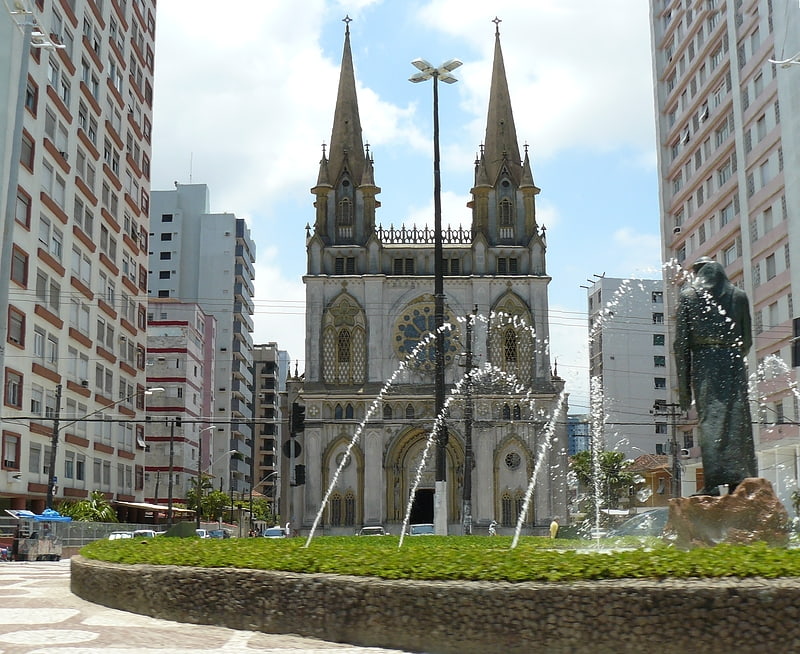
Building in Santos, Brazil. The Basilica of St. Anthony Also Basilica of Santos It is a Catholic church inaugurated in 1945 in the city of Santos, Sao Paulo in the south of Brazil, that was built in the style of neo-Gothic architecture.
The basilica originates in the small chapel built in the middle of 1874 by Antonio Ferreira da Silva, then Baron de Embaré. After his death, the chapel was abandoned for twenty years, when it was rebuilt and inaugurated in 1911. In 1915, it expanded, becoming the church. It was delivered in 1922 to the Capuchin friars, who started the new building in 1930, when they placed the cornerstone that would lead to the current basilica, which finally opened in 1945 and was elevated to the category of basilica by Pope Pius XII in 1952.[46]
Address: Av. Bartolomeu de Gusmão, 32, Santos
Theatro José de Alencar, Fortaleza
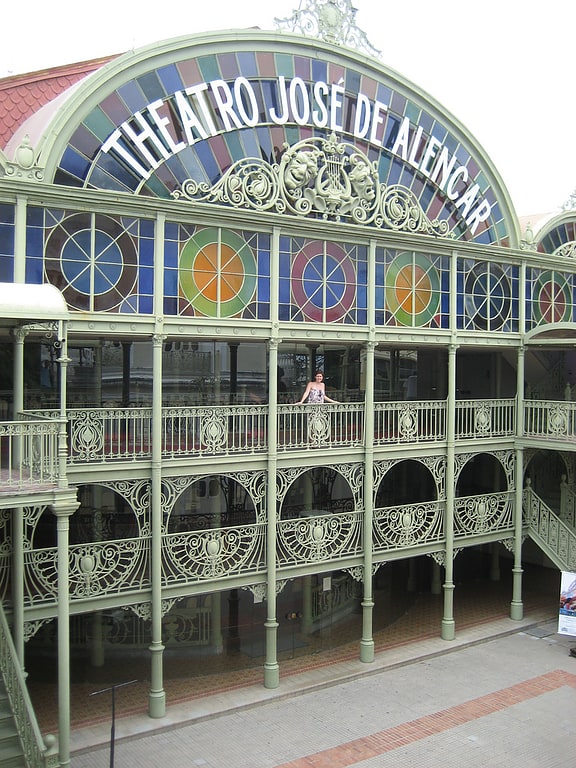
Theater in Fortaleza, Brazil. The Theatro José de Alencar is a Brazilian theater located in the city of Fortaleza, Ceará.[47]
Address: Rua Liberato Barroso 525, 60030-160 Fortaleza (Regional II)
Palácio Rio Negro, Manaus
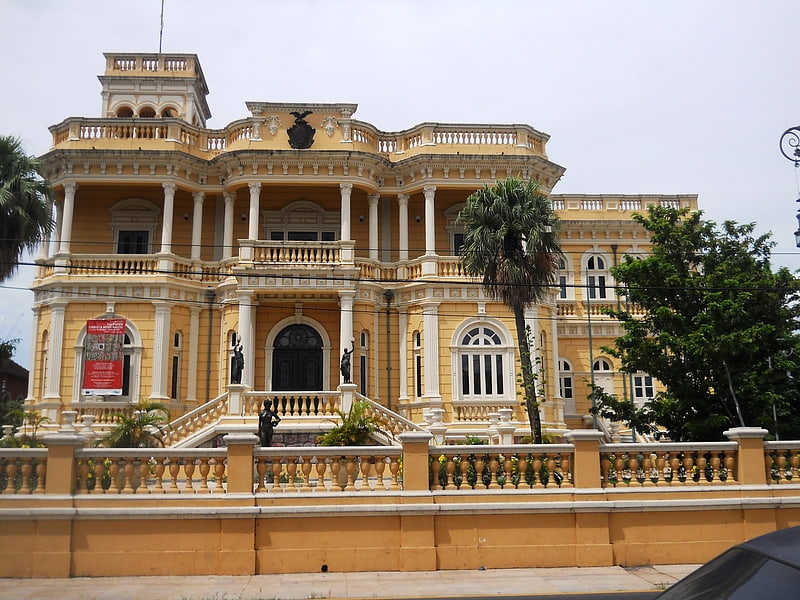
Cultural center in Manaus, Brazil. The Palácio Rio Negro in Manaus, Brazil, is a former seat of government and residence of the governor of the state of Amazonas. The original name was Scholz Palace, built by the German entrepreneur Karl Waldemar Scholz, who was considered to be a "Rubber Baron". The name was changed to Palácio Rio Negro in 1918 when the palace was purchased by the governor of the Brazilian state of Amazonas, Pedro de Alcântara Bacellar.[48]
Address: Avenida 7 de Setembro 1546, 69020-125 Manaus (Zona Sul)
Our Lady of the Conception Cathedral, Campinas
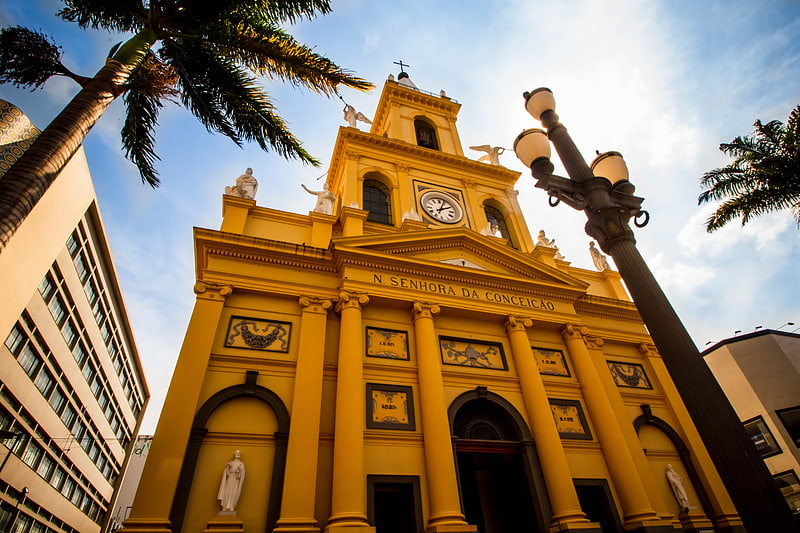
Also known as: Catedral Metropolitana de Campinas
Cathedral in Campinas, Brazil. The Metropolitan Cathedral of Our Lady of the Conception, also Campinas Cathedral, is a Catholic church in Campinas in the state of São Paulo, Brazil. It was inaugurated in 1883 and is located in the Jose Bonifacio Square, popularly known as the Cathedral Square, in the city center. It is dedicated to Our Lady of Conception.
Construction of a new church in Campinas was approved by the City Council in 1807. It was constructed on being the huge bases using rammed earth construction. The structure built by the slaves and blessed by the vicar. It was inaugurated in 1883. The cathedral received new ornaments on the facade during a large-scale restoration in 1923.[49]
Address: Pça. José Bonifácio, Campinas (Distrito Leste)
Fortaleza de Nossa Senhora da Assunção, Fortaleza
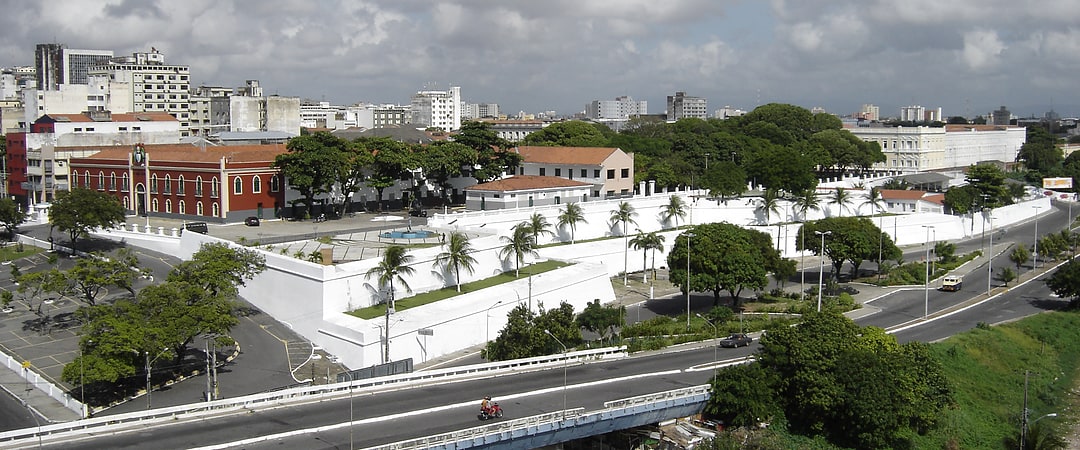
Historical landmark in Fortaleza, Brazil. Fortaleza de Nossa Senhora da Assunção is a fort located in Fortaleza, Ceará in Brazil.[50]
Address: Avenida Alberto Nepomuceno 199, 60055-977 Fortaleza (Regional II)